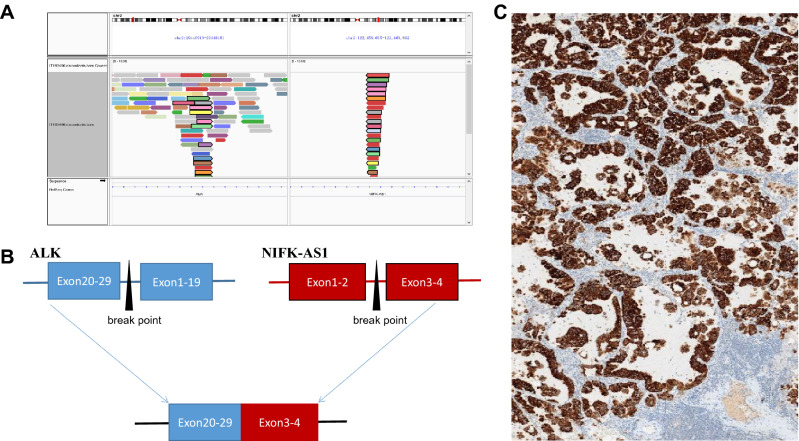ALK rearrangement has been proven as an oncogenic driver in patients with lung cancer. EML4-ALK was identified first and remained approximately 95% fusion variant in ALK + NSCLC (Soda et al. 2007). However, the functional significances are distinct with different fusion parters (Ou et al. 2020). Therefore, the need to identify and elucidation rare actionable driver mutations is urgent and huge. Here, we report a novel ALK rearrangement which consists of exon 3–4 of NIFK-AS1 and exon 20–29 of ALK.
A 59-year-old male presented with ground glass nodules in the right upper lung, blood in sputum, no fever, chest pain, or cough. No significant weight loss was observed, and routine urine and feces were normal. Thoracoscopic resection of the right upper lung was performed, and intraoperative exploration showed no invasion of the visceral pleura. After segmentotomy, a gray nodule with a diameter of 0.8 cm was found. Rapid intraoperative pathology indicated adenocarcinoma in situ with microinvasion.
Expert consensus on clinical practice of ALK fusion detection in non-small cell lung cancer in China strongly recommends that all patients diagnosed by pathology as lung invasive adenocarcinoma (including adenocarcinoma components) should undergo ALK gene testing regardless of their stage. Genetic testing containing EGFR, ALK, ROS1, BRAF, KRAS, ERBB2, RET, MET, PIK3CA, and NRAS was performed using formalin fixed paraffin-embedded tissue. The patient’s next-generation sequencing results defined a novel ALK rearrangement, such as other oncogenic ALK rearrangement, which retained exons 20–29 of ALK, coding for the tyrosine kinase domain. The Integrated Genomics Viewer (IGV) shows supporting sequencing reads. IHC assays (D5F3, Roche Benchmark XT) were performed and this translocation could remain the expression of ALK protein (Fig. 1). The patient harbored no mutations in the remaining nine genes.
Fig. 1.
A Integrated Genomics Viewer snapshot showing paired-end sequencing data demonstrating the novel ALK translocation. B Schematic diagram of the novel ALK translocation. C ALK + confirmed by IHC
To our knowledge, this is the first report of an ALK + rearrangement which retained exons 3–4 of NIFK-AS1 fused to exons 20–29 of ALK. Our work extends the spectrum and genomic landscape of oncogenic ALK rearrangement in NSCLC. We reported the novel fusion with information on the exon and fusion breakpoints and confirmed that the tumor is IHC positive. It is expected that the patient will benefit from ALK inhibitor after tumor recurrence.
Acknowledgements
The authors thank the patient and his families for agreeing to use his data for research purposes, and specifically, for publication of this report. Thank Precision Diagnosis Center of Dian for providing technical help.
Author contributions
JC and ZY drafted the original manuscript together, XL collected clinical data, GX did bioinformatics analysis, and YW did supervision, writing–reviewing and editing.
Funding
This research did not receive any specific grant from funding agencies in the public, commercial, or not-for-profit sectors.
Declarations
Conflict of interest
The authors declare that they have no competing interests.
Footnotes
Publisher's Note
Springer Nature remains neutral with regard to jurisdictional claims in published maps and institutional affiliations.
Jian Chen and Zhaonan Yu contributed equally to this work.
References
- Ou SHI, Zhu VW, Nagasaka M (2020) Catalog of 5’fusion partners in ALK-positive NSCLC Circa 2020[J]. Jto Clin Res Rep 1:100015 [DOI] [PMC free article] [PubMed] [Google Scholar]
- Soda M, Choi YL, Enomoto M et al (2007) Identification of the transforming EML4–ALK fusion gene in non-small-cell lung cancer[J]. Nature 448(7153):561–566 [DOI] [PubMed] [Google Scholar]



